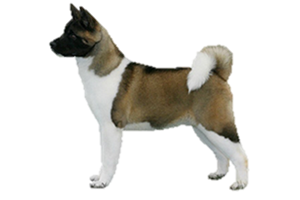American Akita Standards
- 24-28"
- 75-120 lbs
- large spitz with erect, triangular ears
- curled tail is carried over back or against flank
- double-coated, outer coat is straight and harsh
- can be any color
- may or may not have a black mask
History of the American Akita
American Akitas are direct descendants of the ancient Akita Inu of Japan. At the end of WWII many servicemen brought “Akitas” home with them to the United States. Most of these dogs were in fact German Shepherd/Akita crosses, a result of the Japanese culling all non-military dogs during the war. Owners hoping to see their dogs spared out crossed them with German Shepherds, the only dogs to escape the cull.
Breeders had different views on where to take the Akita in the United States and Japan, creating two varieties. The American Akita is larger and often described as having a bear-like head, while the Akita Inu is more fox-like. Americans also favor the pinto markings, which is strictly forbidden in Japan.
The two types of Akitas continued to be bred for different standards for over 50 years. In the late 1990s, the Japanese Kennel Club began requesting the two be split into separate breeds. The Fédération Cynologique Internationale (FCI) made a formal announcement doing so in 1999. Originally the name chosen for the American Akita was the Great Japanese Dog, however this title was changed in 2006.
In the United States the Akita Club of America chose not to follow suit with the FCI. As the American Kennel Club (AKC) looks to each breed’s parent club for written standards this has caused the Akita to remain as one breed under their jurisdiction. By continuing to lump the two together most Akita Inus cannot be shown under current AKC rulings.
Related Breeds:

